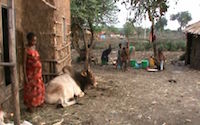Bayso and Haro are two of the languages spoken in the North Omo Zone, formerly known as Gamo-Gofa, in the Southern Nations, Nationalities and Peoples Federal State in Southern Ethiopia. Only the Bayso are officially recognized among the peoples of the North Omo Zone, together with the Gamo, the Gofa, the Zayse and the Oyda. Their official name is Gidiccho, which is the name of the only inhabited island of the Abbaya Lake that is considered the homeland of the Bayso and is also inhabited by members of the Haro group. The Haro are not recognized and are subsumed under the term Gidiccho.
Classification
Bayso and Haro are two Afroasiatic language belonging to two different groups of this language family: Bayso is Cushitic and Haro is Omotic. Bayso is part of the Omo-Tana subgroup of East Cushitic. In particular, it is included in the East Omo-Tana cluster together with Rendille, Boni and Somali. Haro is part is on the Ometo languages of the Omotic group. Within Ometo it one of the East Ometo languages together with Zayse, Koorete, Ganjule and Getsame, all languages spoken on the coast of the Abbaya lake and the near-by Chamo lake. Within East Ometo, Haro has a particular affiliation with Ganjule and Getsame with which it forms a dialectal cluster.
Characteristics of Bayso grammar
Bayso phonology
Bayso consonant phonemes can be classified as follows. It is to be noticed the presence of a rich series of glottalic (ejective and implosive) phonemes. These are: p’ t’, k’, s’, tʃ”, m’, n’ l’, r’ and ɗ.
| Bilabial | Labiodental | Alveolar | Palatal | Velar | Glottal | ||
| Stops | voiceless | p | t | k | ʔ | ||
| voiced | b | d | g | ||||
| implosives | ɗ | ||||||
| ejectives | p’ | t’ | k’ | ||||
| Fricatives | voiceless | f | s | ʃ | h | ||
| voiced | z | ||||||
| ejectives | s’ | ||||||
| Affricates | voiceless | tʃ | |||||
| voiced | dʒ | ||||||
| ejectives | tʃ” | ||||||
| Nasals | m | n | |||||
| ejectives | m’ | n’ | |||||
| Liquids | lateral
flap |
l
r |
|||||
| ejectives | l’
r’ |
||||||
| Glides (Semi-Vowels) | w | j |
The vowel system is structured in five cardinal vowels /a, e, i, o ,u/ and their long counterparts /aa, ee, ii, oo, uu/.
Bayso major morphosyntactic features
The basic word order for neutral clauses is SOV, which is characteristic of most of the languages of the Ethiopian area. The word order is modified in cleft sentences, a pragmatic strategy that is widely used in the language. Modifiers follow their head.
As for nominal morphology, on the basis of the agreement system it is possible to classify Bayso nouns into three genders: masculine (M), feminine (F) and plural (P). The peculiar aspect of Bayso gender classification, shared by other East Cushitic languages, is the presence of the P. This has to be called plural since the agreement of nouns having this gender is with plural predicates and modifiers. In spite of this agreement, it is not possible to state that these nouns are plural number-determined because number determination operates through suffixation of a plurative suffix. Number specification as “one” or “many” is realized by morphologic number derivation of number-unmarked basic nouns. There are three kinds of number derivation: singulative (SING), plurative (PLUR) and paucal (PAUC). Singulative indicates a unit. Plurative is not just used to indicate more than one or many or a plurality but groups of different units that are more than five, paucal indicates a group of different units that is from two to five.
Verb morphology is Bayso is quite rich and complex. About twenty different paradigms applying to conjugation of four different verb types have been found, even if some of which only partially attested in the corpus. The structure of most of the paradigms includes verb auxiliaries that lost their semantic values and are integrated in the expression of tense and aspect. In total there are three perfect paradigms, five imperfect paradigms and five so-called subordinate paradigms.
Bayso has also a verbal derivation system. Derivational suffixes are attached to basic verb stems to modify the valence of the verb thus becoming causative, middle or passive. Some suffixes are verbalizers and are used to form verbs from adjectival stems. Some verbal stems have incorporated the derivational suffixes. In this case, no basic forms without derivational suffixes are attested.
Characteristics of Haro grammar
Haro phonology
Below is a chart of the Haro consonantal phonemes. It is noteworthy that the occlusive consonants can be voiced, voiceless or glottalic and that all stops, except the glottal one, the alveolar fricative and the palatal affricate contrast voiceless, voiced and ejective and/or implosive phonemes.
| Bilabial | Labiodental | Alveolar | Palatal | Velar | Glottal | ||
| Stops | voiceless | p | t | k | ʔ | ||
| voiced | b | d | g | ||||
| implosives | ɓ | ɗ | |||||
| ejectives | p’ | t’ | k’ | ||||
| Fricatives | voiceless | s | ʃ | h | |||
| voiced | z | ||||||
| ejectives | s’ | ||||||
| Affricates | voiceless | ts | tʃ | ||||
| voiced | dʒ | ||||||
| ejectives | tʃ” | ||||||
| Nasals | m | n | |||||
| Liquids | lateral
flap |
l
r |
|||||
| Glides (Semi-Vowels) | w | j |
The Haro vowel system consists of five phonemic short vowel /a, e, i, o, u/ and their long counterparts /aa, ee, ii, oo and uu/.
Haro major morphosyntactic features
The basic word order for neutral clauses is SOV. Modifiers follow the modified element.
A relevant characteristic of Haro nominal morphology is the presence of the so-called Terminal Vowels (TV, Hayward 1987:215) -a, -e, -i and -o. These vowels have lexically-determined noun classifying function, but the -o indicates feminine gender. The morphological status of the TV is unstable since they are sometimes replaced by other suffixes and sometimes they appear as part of the root. Gender on nouns is otherwise indicated by the definite suffix and the absolutive case. Number indicates either plural or paucal, while basic nouns are interpreted as number-unmarked or singular.
The case system of Haro is very interesting and is also found in other Cushitic and Omotic languages. The language has a so-called “marked nominative” case system in which the nominative marks the subject of both transitive and intransitive verbs. The nominative case is opposed to the absolutive, which does NOT mark the subject of an intransitive verb (as commonly happen in the description of ergative systems), but is a core case with a wide range of syntactic functions, it is used as direct object (one would expect an accusative case) as a predicate form and in citation form.
Together with the genitive, nominative and absolutive are core cases. Peripheral cases are dative, instrumental, comitative, locative, ablative, directive and vocative.
As for the verbal system, Haro makes extensive use of a-temporal and uninflected action nominalized forms. The verbal paradigms are divided according to modality. A declarative clause marker attached to the verb stem to indicate present and follows other elements attached to the stem for the expression of past, progressive, imperfective and perfective. Future does not show the declarative clause marker as it is semantically embedded to the expression of epistemic modality: certainty, possibility and conditionality. Negative verbs have an uninflected form and are followed by a negative declarative suffix. Other non-declarative forms that do not show the declarative marker are imperative, prohibitive and exhortative.







